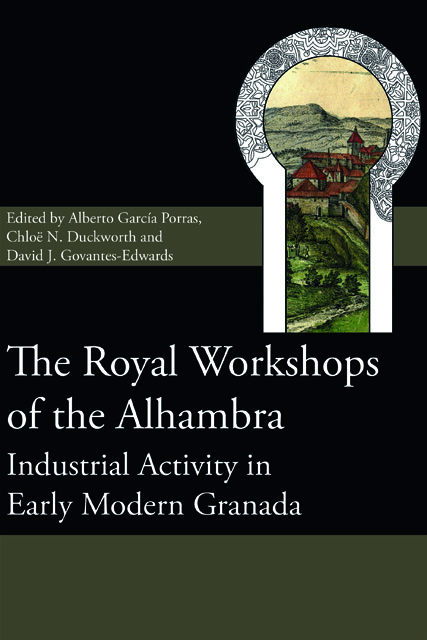Book contents
- Frontmatter
- Contents
- List of Illustrations
- List of Contributors
- Acknowledgements
- Foreword
- Introduction
- 1 The Secano: the city of the Alhambra
- 2 A holistic and reflexive methodology for the archaeological investigation of pyrotechnological activity in the Alhambra
- 3 The modern kilns
- 4 Geophysical and geochemical exploration of the industrial areas in the Alhambra
- 5 The excavation of the area of the Secano in the Alhambra: Trench 1
- 6 The excavation of the area of the Secano in the Alhambra: Trench 2
- 7 The pottery
- 8 Glass in the excavation of the Secano, the Alhambra
- 9 Furnaces at full blast: the demand for architectural ceramics for construction in the Alhambra (16th and 17th centuries)
- Conclusions
- Index
6 - The excavation of the area of the Secano in the Alhambra: Trench 2
Published online by Cambridge University Press: 20 December 2023
- Frontmatter
- Contents
- List of Illustrations
- List of Contributors
- Acknowledgements
- Foreword
- Introduction
- 1 The Secano: the city of the Alhambra
- 2 A holistic and reflexive methodology for the archaeological investigation of pyrotechnological activity in the Alhambra
- 3 The modern kilns
- 4 Geophysical and geochemical exploration of the industrial areas in the Alhambra
- 5 The excavation of the area of the Secano in the Alhambra: Trench 1
- 6 The excavation of the area of the Secano in the Alhambra: Trench 2
- 7 The pottery
- 8 Glass in the excavation of the Secano, the Alhambra
- 9 Furnaces at full blast: the demand for architectural ceramics for construction in the Alhambra (16th and 17th centuries)
- Conclusions
- Index
Summary
Trench 2 is situated in an area of the Secano that has been paid little archaeological attention to date, immediately N of the southern wall. In fact, when the monumental value of the Alhambra was realized in the 19th century, large quantities of soil and archaeological layers were bulldozed away in a series of terraces in order to leave the wall visible for the visitors. Further uncontrolled archaeological works were undertaken in the mid-1970s, which added to the losses in the archaeological sequence. As a result, large tracts of this area were stripped of soil almost to bedrock levels. The trench aimed to analyse the relationship between a kiln and its nearby archaeological features. The kiln, which is the latest feature in the trench, dating perhaps to the 17th or even the 18th century, presents various traces of reconstruction, repair, and reuse, and is therefore a good illustration of the continuity of industrial activity in the Secano over time. In addition to this, the results of handheld portable X-ray Fluorescence (pXRF) analysis carried out within the kiln prior to and during excavation has identified elements that point to various industrial activities (from ceramic glazing to lime-burning), which suggests that industrial activity was not only continuous but also versatile, and that industrial facilities were used for a range of different purposes. Moreover, the fact that the kiln cut into earlier periods – with a medieval domestic feature and a levelling terrace filled chiefly with Nasrid pottery followed by a series of seemingly early modern features – indicates that industrial activities continued being practised in the Secano long after the closure of the Nasrid workshops, as also suggested by the written evidence.
Keywords: pyrotechnologies; workshops; kiln; pottery; reuse.
Introduction
In the first excavation season (2016), Trench 2 was planned as a 20m rectangular area, but in 2017 its limits were subsequently expanded to the NW and the E in order to explore in more detail the relationships and characteristics of a number of archaeological features identified during the excavation of the original layout of the trench. As a result, the final size of the trench was approximately 32m. The trench was located to the S of Calle Real de la Alhambra, in the terraced area to the N of the S wall (see Fig. B).
- Type
- Chapter
- Information
- The Royal Workshops of the AlhambraIndustrial Activity in Early Modern Granada, pp. 85 - 96Publisher: Boydell & BrewerPrint publication year: 2022



